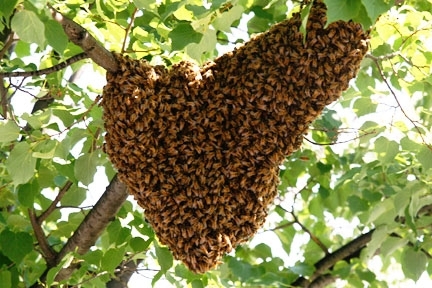Swarm and Bee Removal
Do you have a swarm of honey bees that you would like removed? Our Swarm Volunteers are happy to help because swarms and hives are valuable to us! But before you ask for assistance, please read the following information and be prepared to answer a few questions. Then, you can provide information about the swarm.
What is a Swarm?
Swarming is a natural process caused by congestion in the hive. Early in the spring, the population of the honey bee colony can explode, creating overcrowding. As a result, the colony makes a decision to divide – what biologists call “colony-level reproduction”. The colony begins the magical process of producing a second queen. Once the development of a new queen is well underway, the old queen and approximately half the colony will depart the hive and begin looking for a new home.
Are Swarms Dangerous?
No. A swarm of bees are homeless bees and, as a result, only interested in finding a new home. They have no hive or honey to defend and tend to be non-aggressive and docile. However, that doesn’t mean they won’t defend themselves if someone hits the swarm with a stick!
Should I Spray the Swarm with Gasoline?
Never! Honey bees are an important member of our environment and ecology. We need the honey bees to provide pollination of the food we eat and to provide us with honey.
What if I Decide to Ignore Them?
Once the scout bees have discovered a new home for the colony, they will be on their merry way. Normally, a swarm will depart in a few hours, sometimes a few days.
Please be prepared to answer the following questions when you contact us:
- Are you sure they are honey bees? Yellow jackets and wasps are often mistaken for honey bees. See this identification guide for help in identification
- How big is the cluster and what does it look like? Honey bees cluster as one big mass of bees as shown in the picture at the top of the page. If they are a small cluster around a knot in a tree or hole in a wall they are no longer a swarm but an established hive which is much more difficult and time-consuming to remove. If the ‘ball’ has a gray color or papery look then it is a wasp nest.
- Where is the swarm located? Is it hanging under a picnic table, or in a tree?
- How high is it? Height usually adds to the difficulty of removal and requires ladders or special equipment.
- How long have they been here? Swarms that have been there for more than a few days are probably an established hive. While many beekeepers will handle swarms, far fewer are prepared to handle established hives, especially those inside trees, houses or other structures.
Note that some swarms may be located such that it is next to impossible to remove them. For example, if the swarm is located high up in a tree. If this is the case, the beekeeper will advise you of the situation. Leave the swarm alone and they will be gone in a few hours, or a few days.
Once you have read and understood the above information, click the button below.

